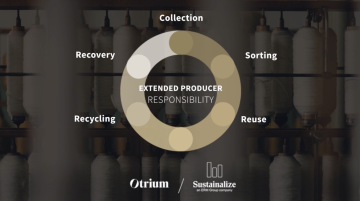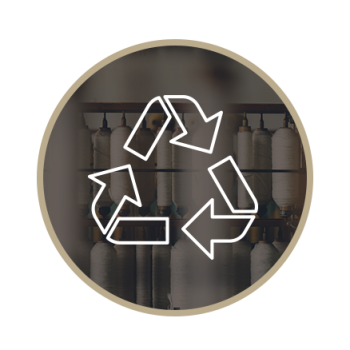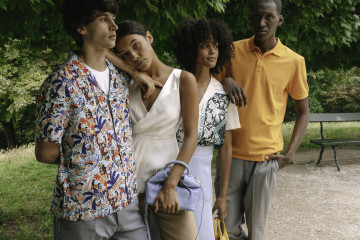Conscious
Unravelling sustainability laws in fashion - Extended Producer Responsibility

We want to help our brand partners, both present and future, keep on top of the newest and forthcoming laws and legislation around sustainability and achieve their Environmental, Social, and Governance (ESG) goals.
3 MAY 2022
At Otrium, we’re constantly working towards making the fashion industry smarter and less wasteful. We also want to help our brand partners, both present and future, keep on top of the newest and forthcoming laws and legislation around sustainability and achieve their Environmental, Social, and Governance (ESG) goals.
So, in collaboration with leading Corporate Sustainability Consultancy Sustainalize, we’re launching a series of blog posts aimed at simplifying these new laws and legislation. These posts will also contain guidance to help fashion brands comply with these policies. We hope they prove to be useful.
First up, is Extended Producer Responsibility (EPR). What is it, and why do fashion brands need to know about it?
EPR - an explanation
Broadly speaking, EPR is a waste management concept aimed at reducing pollution and landfill use, while increasing recycling rates. In fashion industry-specific terms, it’s a policy whereby brands bear a significant degree of responsibility for the environmental impacts of everything they produce, taking the whole life-cycle of garments and accessories into account.
It’s not a new idea - it was first introduced over 30 years ago - but the importance of developing more circular systems for dealing with all textiles is becoming ever more apparent. EPR is intended to reimagine how every company and organisation sources and uses their materials, plus how they dispose of and reuse them.
What EPR would mean
The results of introducing an EPR policy could:
- Incentivise eco-friendly design - in every stage, from concept and materials to packaging
- Improve sustainability in both production and consumption - as brands are obligated to take over the practicalities of waste collection and recycling
- Reduce the amount of products sent to landfill - as brands develop better circular systems for recycling and reusing materials
Currently, the EU’s only mandatory EPR is in France. But several European countries are investigating similar schemes for textiles including the Netherlands and Sweden. The European Commission is considering EPR as a general regulatory measure to promote sustainable textiles and better recycling for textile waste. The UK government has also committed to review and consult on an EPR scheme. Over in the US, various charities and coalitions are lobbying policymakers to make EPR a reality there too. It’s not clear whether any of these will become mandatory, or even coordinated across countries. Either way, EPR and everything it potentially involves is an important consideration for everyone in the fashion industry.
EPR in France
France’s EPR policy was introduced in 2007 and passed into law to cover end-of-use clothing, linen, and shoes in January 2020. The policy is governed by Refashion (formerly Eco TLC), an accredited non-profit organisation, which represents 95% of the French textile industry and is responsible for the collection, recycling, and recovery of used textiles. The destruction of unsold textile products is forbidden under law.
France’s target for 2022 is to collect 50% of all the textiles put on the market, and from this collection, reach 95% of reuse or recycling of textiles, and a maximum of 2% waste. Policymakers have also implemented an extension of circularity on transparency of the production, as well as the bonuses and penalties paid by the manufacturers and information on potentially dangerous substances.
EPR in The Netherlands
The Netherlands has a draft regulation that focuses on garments and home textiles.
All producers in the Netherlands, as well as external producers who market within the country (including ecommerce), need to appoint a legal entity to carry out the EPR.
By 2025, municipalities will have to collect textiles separately.
The Dutch government has a target for 2025 that 50% of textile products should be recycled or reused. Producers are obligated to report their figures annually. By 2030, this target will increase to 75%. The estimated cost of waste management for producers is €0.09 to €0.28 per kilogram of textile.
EPR in Sweden
Sweden introduced an EPR for textiles from 1 January 2022. It will be phased in over several years with licensed textile collections starting on 1st January 2024. It’s hoped that from 2028 onwards, at least 90% of the textile waste collected by the new system will be reused or sent for material recovery. Sweden’s target by 2028 is to reduce the average amount of textile sent to landfill by 70%.
How to prepare for EPR
While the whole industry waits to find out whether these potential EPR regulations will be set in stone, there are two different initiatives that brands can consider implementing to get ahead of the pack.
- Develop a Digital Product Passport (DPP)
A DPP is a QR code, hardware tag or similar, which provides digital information and data about a product. One initiative of note is the new CircularID Protocol by Eon, a global identification system for apparel products, developed by leading fashion brands, retailers, and other stakeholders.
There are other pilot DPP projects in the works, from the EC itself, the American Apparel and Footwear Association, IBM and the Aura Blockchain Consortium. The first step before engaging with any of these pilot DPP projects, of course, is for brands to align their products and processes with current standards.

- Develop and integrate an EPR-friendly business model
Integrating a circular system within a business strategy is a must for fashion brands in 2022 and beyond. Many brands have been pioneering solutions to integrate, reuse and recycle in their production. There are a few different but relevant business models here:
- In-house recycling:
Customers bring back old clothes in exchange for a discount coupon. The garments brought back are divided into three categories: recycle (shredded into textile fibre), resale (via the secondhand clothing market) and restyle (fabrics are used to make new clothing or accessories. H&M has a successful program for this model, launched back in 2013.
- Online marketplaces:
Apps and websites for individuals and small businesses to buy and sell small runs and second hand garments, and engage in collaborative consumption. ASOS Marketplace is a great example of a clothing brand and retailer branching out in this way.
- Eco-design:
Working sustainability into new designs and product lines. Brands of all sizes now have programs entirely aimed at reducing the environmental impact of their products. On Earth Day last year, Adidas launched their Ultra Boost “Made to be Remade” trainers. They’re totally recyclable, made to be returned to Adidas at the end of their life, to be remade into a new pair of shoes. Outdoor brand Decathlon uses 39 million discarded plastic bottles each year to create hiking fleeces made of recycled polyester.
- Luxury second hand retail:
In 2019, the clothing resale industry grew 25 times faster than the wider retail industry and is expected to overtake traditional thrifting and charity donations by 2024. Retailers can jump on board by setting up platforms offering affordable second hand designer brands. Online luxury fashion site Farfetch does this with their pre-loved designer bags section.

Ways Otrium can help
At Otrium, we’re constantly working towards making the fashion industry smarter and less wasteful. Our purpose is simple: all clothing should be worn. It’s why we use data to solve the excess inventory problems that fashion brands often face. And it’s why we polish archive garments we receive from brands, repairing, pressing and steaming them so they regain their value, and have the best chance at finding a new home.
It’s also why we carefully repair and refurbish all our own returns, keeping them out of landfill. Any items that we cannot refurbish into good-as-new quality are stored separately at our warehouse in a separate section. Currently we are working on setting up our own circular program pilot to find a way to repurpose these.
Partnering with Otrium to match end of season and archive collections with our community of fashion-lovers is an ideal way for brands to be more circular. From the design stage and managing supply and demand, to dealing with unsold products, our data-driven systems are successfully saving many thousands of items from ending up in landfill.
Can we help your brand? Get in touch with us.
About Sustainalize
We are Sustainalize, a new generation of sustainability specialists. Since 2010, we have grown from an unknown small-scale interrupter to a strong market leader in the field of sustainability advice. As an ERM Group company, Sustainalize is now part of the largest pure-play sustainability consultancy in the world.
A sustainable future requires companies to focus on creating long-term value. Value for people, the environment and society, combined with healthy financial results. But how do you manage that? By staying inventive. We are results driven, ahead of the curve when it comes to the latest innovations and regulations. And we’re more than happy to share them with you.
Stakeholders, laws and legislation, and rating agencies increasingly expect companies to be open in their sustainability policy and performance. We’re familiar with various methodologies and understand the challenges involved in complying with (forthcoming) laws and regulations. In addition, together with our valuable partnerships, we can help to quantify - and communicate about – your sustainability performance. We translate your needs into a concrete improvement plan and connect this with your business strategy.
Sources
More from Otrium
See all articles
Conscious
Part 1: The Industry
The fashion industry is trapped in a broken cycle because trends come and go at breakneck speed, creating stress and waste for brands, people, and natural resources. Fashion is such an important part of our lives (naturally!), but sadly, it’s also a significant contributor to the climate crisis, because of this, we must build a smarter fashion industry.The carbon footprint of the fashion industry was 4% of the global total in 2018 (McKinsey & Company and Global Fashion Agenda). This equals the combined annual footprint of France, Germany, and the United Kingdom. It is predicted that over the next decade, beyond measures already in place, the industry’s carbon dioxide emissions will likely rise to an annual volume growth rate of 2.7% (McKinsey & Company and Global Fashion Agenda).At Otrium, our philosophy is that a fashion item that’s produced as a creative passion for humans, using materials extracted from earth, shouldn't collect dust in a warehouse or end up in landfill. We’d love to see a future where every clothing item produced is worn, and we’re working with hundreds of brand partners to achieve this.. Through our brand partnerships, we aim to reduce the overall amount of waste in the industry and follow a more circular approach. Since the industrial revolution, the fashion industry has been dominated by a one-way, linear model of production and consumption, raw materials are collected, transformed into short lived products, and then thrown away. Currently, approximately one in every ten items of clothing produced, or more than $200 billion worth, stay unsold, sitting in warehouses. Fashion and the freedom of self expression that clothing offers us, is not to be wasted. We’re here to change the status quo. We believe that fashion’s linear ‘take-make-waste’ model can be transformed into a circular approach that is restorative and regenerative by design. To help diminish the take-make-waste pattern, we are attempting to close the loop. As an industry with inherent waste, one of which has such a large impact on people and the environment, we want to make it our responsibility to start by closing the loop. It’s time to design out waste:Circularity or the circular economy is a system of closed loops in which raw materials, components and products loose as little value as possible renewable energy sources are used, and systems thinking is used. Much like the circle shape, the garments and products are put back into the cycle of the industry, rather than ending up in landfill sites or disregarded as waste. This is a purpose we care about at Otrium. Today, consumers care more about what they buy and how it will impact people and the environment. Our own research found that ⅓ of our customers are ‘Sustainable Shoppers’. When shopping at Otrium, these shoppers can be reassured that we are working towards a more circular future for fashion. Let’s be the solution, let’s become circular. Read more about our impact here: undefinedundefinedundefinedundefined

Conscious
Part 2: Otrium's Role
Otrium was founded with the purpose that all clothing should be worn. One in ten items made are never sold – this is not only a huge waste of the creativity and labour that goes into their production, but a waste of investment and natural resources. Founders, Milan and Max, wanted to change this.We’re a purpose-driven, end-of-season fashion platform, developing technology and using data to match supply and demand within the fashion industry to reduce this impact. We’re changing the way fashion is created and sold through our technology which finds a match for every item on our platform, and then through our data, informs demand-based clothing creation. Fashion is trapped in a broken cycle of overproduction; creating stress and waste for brands, people, and natural resources. The industry is at a turning point, and thanks to technological advancements across the board, it’s the right time for us all to be pioneers of new and better solutions. Being purpose-led is at the core of everything we do. Similar to the circular model, at Otrium, we aim to close the loop of the previously linear industry model, by selling the unsellable: we polish, match, use data, and refurbish. How? 1. We polishWe receive and ‘polish’ items to regain value. From product description, photography, packaging, and pressing, we ensure that every piece is ready to be adored by a new owner. We have state-of-the-art warehouses with top-quality equipment, to bring items back to life. Often, returned garments only require tiny ‘tweaks’ to be ready for sale, but are instead left lying in storage or end up as landfill.2. We matchWe find a match – an owner for every item on our platform. And for the small portion of items that cannot be sold on our platform, we sell them to stock buyers. As a company, we are motivated by our leading philosophy, that all clothing should be worn. Because of this, we use technology and data to match supply and demand in the most efficient way possible, matching each item to a fashion lover. 3. We use data Together with our partner brands, we use insights to create demand based fashion which removes the likelihood of excess inventory. We're taking the guesswork out of fashion production with data informed forecasting to reduce unsold inventory coming into the supply chain to start with.4. We refurbishMany returns in e-commerce remain unsold because they are returned with minor imperfections, some damage or are just not worth investing in repressing and repackaging, fixing up labels etc. We believe it's worth the effort, so we refurbish as many items as we can to ensure that they're sold and worn. Change for us starts with measuring and quantifying our impact. We approach our impact in two key ways; having no negative impact as a company, and having a positive impact on the industry. What? It is in our best interest to measure, monitor, map out, and change our processes where necessary. We are committed to measuring and managing our environmental impact from the perspective of our brand partnerships and the fashion industry as a whole. Our organisational boundary is set in accordance with the Greenhouse Gas Protocol – a global standardised framework to measure and manage greenhouse gas (GHG) emissions.Why? Almost 40% of our global greenhouse gas emissions can be traced back to energy generation, and half of that energy is used by industrial or commercial entities. We continually measure our environmental impact in order to manage it and keep it as low as possible. We measure our Carbon Footprint (+ link to report), through three scopes: 1. Controlled GHGs (combustion from the office and vehicles) 2. Indirect emissions (electricity) and, 3. Emissions resulting from activities (packaging, warehouse, and logistics). How? Due to the fact that we are a data-driven organisation, we use metrics and insights to inform our decisions. In order to track our impact, we’ve produced three reports. Each report looks into our impact, how we measure our impact, and what the future looks like: undefinedundefinedundefinedWe created these reports as a baseline to understand our impact and set goals. Moving forward Otrium is determined to drive this research forward to improve transparency in the fashion industry as a whole and to validate and quantify the impact of our business model. The first step is to find the right partners and institutions to collaborate with on this research. What calculations will we be making? We’ll analyse our material data and use it to build a strategy for lowering our impact. By nature, the fashion industry is diverse with an eclectic mix of styles and preferences. Because of this, it is important to have an in-depth understanding of the different materials we are working with. Secondly, we’ll carry out order process calculations, including those for the Carbon Dioxide that is expelled as a result of packaging and transportation. In addition, we will be assessing the life cycle of our fashion brands. For example, how much energy did it take for a product to be made? We will publish our 2022 results and actively communicate our progress and findings via the Conscious page on our platform. So keep your eyes peeled!

Conscious
Part 3: Looking Ahead
To reach our goal, we have a journey ahead of us. A journey we’d like our customers to be a part of. 2020 and 2021 may have been pretty unpredictable years, we’re glad to have made more progress than we had thought was possible. Making a positive impact however, is an ongoing journey, and we continue to improve over time. We are proud of measuring our impact through reporting, through which we’ve released three reports: undefinedundefinedundefinedThe goal of these reports is to have reliable data to feed into our sustainability strategy moving forward. The reports are based on the year 2020, they function as a baseline to understand our impact and set goals, as well as functioning as a benchmark for our future. To ensure that we efficiently track and leverage our sustainability strategy, and to ensure full transparency, we plan on reporting the same data annually, At Otrium, contributing to positive change has always been our main priority. Looking back, here are some highlights throughout 2020 and 2021: 2020 ‘19 to ‘20 Refurbishing returns We extended the life cycle of slightly imperfect returns by refurbishing them by hand to an as-new condition and offering them a second chance to find a new owner on our platform. Why is this important? Returns provide another opportunity for clothing to be mismanaged and they end up not being worn. We want to prevent any chance of this happening, elongating all journeys that the items go through. March ‘20 100% recycled packaging We aim to create a sustainable journey, from item creation to boxing, through to wearing. Our shipping boxes are made out of recycled cardboard and are based upon the measurements of the pallets of our forwards to ship as efficiently as possible. Through measuring efficiently, we use the least amount of surface area as possible. Additionally, our poly bags are made out of 100% recycled polyester and are only used in case an incoming item is missing one.April ‘20 Improving the last mile The start of our last mile project. The last mile project was initiated in order to improve the carbon footprint of our shipments. How? We decided to partner and work with alternative transport systems such as bicycle couriers in the Netherlands.
2021 March ‘21 Sustainability function Otrium was founded as a purpose-driven company. In 2021 we hired a dedicated Sustainability Lead to ensure our purpose remains focused and understood by our consumers. April ‘21 Fit finderIn order to reduce returns, we implemented a size recommendation tool. The tool combines production size chart data and body-modelling knowledge with the world’s largest collection of sales and return records to provide the most accurate fit prediction. July ‘ 21 Official fur free retailer From a day-to-day perspective the platform stayed the same, as we did not have any garments that contained real fur. This accreditation made the fur-free status official – for our customers and for our partners.As you can see, we’re on quite the journey to becoming conscious, come along with us!We see a future where all clothing is worn. Our role as a business is to eradicate unsold inventory and change the way clothing is produced, bought, and considered. We aim to have a positive impact on the fashion industry, to help give fashion a bright future. Every year, billions of items are produced globally but are never sold and go unworn – this is a huge waste of creative energy, labour, natural resources, and investment. Right now, waste is built into our linear industry model, something that we as a company have the responsibility to help fix. Laws are being enforced which will require the fashion industry to significantly reduce the amount of waste, therefore, change is inevitable. So, how is Otrium helping the industry change?Our ambitions are a two-fold: 1. Our impact on the fashion industry We want to help fashion brands and our members to become more circular by creating an infrastructure to regain value of inventory streams and give all items a new lease of life. We are a data-led platform, using customer insights. We use data to help inform brands’ new collections; meaning brands are only creating what consumers want to buy. We only use data that our customers are happy for us to use informing brands what it is they’re looking to buy.2. Our own impact - carbon footprint We are committed to measure and manage our environmental impact. How? By making smart choices. Package redesign, bike delivery, solar panels and electric vehicles are just some examples of these. We are setting targets within the environmental management system to achieve optimal and continual improvement. We will report on a yearly basis, providing buyers with valuable insights - we’re big on transparency. We plan on reducing our impact by reviewing and acting on our practices and processes, and to offset the effect of the carbon we cannot reduce. We have committed to investigating new forms of offsetting which can make the largest impact. True to our values, we're investing in offsetting technologies at the cutting edge, which can remove carbon from the atmosphere.
What’s in our future plan? (some sneak peeks)...We’re working with frameworks and targets to lower our greenhouse gas emissions as much as possible. Our rescue strategyScaling refurbishment by taking in slightly imperfect items from our brand partners, refurbishing them by hand to as-new condition, and offering them a second chance to find a new owner on our platform.Our carbon strategy We’ll publish our carbon strategy to show our impact. Our actions to lower our greenhouse gas emissions by as much as possible. Additionally, we will report our carbon footprint yearly, reducing the impact we make, and simultaneously removing the emissions we cannot avoid yet.Redesign of the packaging We redesigned our shipping boxes to lower our carbon footprint, using thinner, unbleached, recycled cardboard, as well as adding an envelope to avoid shipping air for smaller items.Onboarding more conscious brands We are in the process of onboarding more fashion brands that are rated conscious by Good On You.Solar panels on our warehouse Our warehouse and fulfilment partner is working on a zero-waste program and transitioning to run on energy generated by their own solar panels.We’re excited about the future, and yes, it may sound ambitious, but we’re truly steadfast in looking to improve the fashion industry through a more circular approach.
Join the movement
Subscribe to Our Newsletter
Get the newest discounts, brands, and drops.
Otrium
Customer service
Customer service
© 2016-2025 Otrium, except certain content provided by third parties
